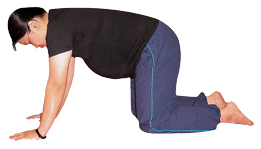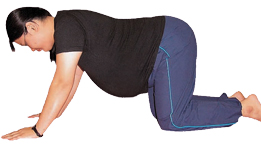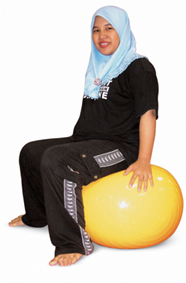Exercising is a challenge for most pregnant women. But once you have explored the benefits and correct ways of exercising, you will find that it is actually safe and worthwhile.
Having a baby is not a stroll in the park. However, the discomfort you feel can be reduced if you keep exercising. Better yet, execise does not need to be vigorous for you to reap its benefits.
Many women know that exercise is good but many still don’t make it a practice. If you are one of them, aim to make a start and eventualy turn it into one of the best habits you could possibly cultivate.
Start with something simple, like taking a short leisurely walk around your neighbourhood padang. Even going halfway and turning back will be fine if your pregnancy is advanced. Get hubby to join you – it’s always more fun when you have company.
You might find the first session tiring. The second will be better and by the third, you will be able to feel the difference exercise makes to the way you feel. Keep it up and exercise will soon be a part of your every day. It’s best for you to want to exercise for your own good. But if this still isn’t enough to motivate you, do it for baby’s sake.
It’s Great To Exercise While Pregnant Because It …
- Improves your posture and relieves backache. When your abdomen increases in size, your posture will shift forward, putting your lower back muscles under a lot of strain. Exercise strengthens and tones those muscles, thus helping you to maintain good posture which goes a long way in keeping the backaches at bay.
- Improves blood circulation. It goes without saying that if you have good circulation, you would be more efficient at supplying baby with oxygen and nutrients through the blood that passes between the two of you through the placenta. But that’s not all – your improved circulation may help reduce the likelihood of you developing varicose veins, cramps and swelling in the feet and legs.
- Reduces constipation. It’s true! Exercising does help make bowel movements more regular.
- Helps you feel and sleep better. Having a baby puts you under a lot of stress. Exercise releases the ‘feel-good’ hormones in your brain, called endorphins, which help to relieve stress. This gives you a more positive outlook about being pregnant.You will find that you can sleep better, too, once your mind is cleared of anxiety.
- Prepares you for birth. Giving birth is often a strenous event and you need to be fit and ready for it. With exercise, your heart and lungs will work better, giving you the stamina you need to huff and puff your way through labour. Stronger muscles (particularly in the abdominal and pelvic region) will help you cope with the strain and lessen the pain.
- Maintain healthy body weight. If you continue exercising and consuming a healthy diet, you will be less likely to gain excessive body weight which can cause complications for both you and baby during pregnancy and birth. Anyhow, women who are generally active during pregnancy find it easier to return to their prepregnancy body weight after giving birth.
Exercising To Stay Fit
- Start by being more active at home. It really doesn’t matter whether it’s sweeping the floor, pruning the shrubs or whatever else you fancy, so long as you get moving.
- Strengthen your heart and improve blood circulation with low-impact exercises that don’t put too much strain on the joints (eg stationary biking, swimming and walking).
- Avoid activities that involve deep bending and extending of the joints, jumping, jarring motions or rapid changes in direction.
- Do not strain to the extent that you can’t even talk while exercising.
- As a rule, the more advanced your pregnancy, the less intensive your exercise should be.
Exercising To Stay Strong
- Training with light weights is allowed but you should refrain from lifting them over your head.
- Avoid exercises that require you to hold your breath (eg while lifting healthy weights) or to exhale against a closed mouth and nostrils.
- Resistance training (like rowing or exercises that require pushing or pulling) are best kept at low intensity. Start taking exercise seriously! Do not let the discomfort during pregnancy hinder you from exercising or continuing an exercise programme. As long as you start slowly and exercise correctly, you can enjoy the assurance that it brings better health to you and your baby. Once you are physically prepared for labour and birth, you will feel better and have a happier disposition, too.
EXERCISE THESE SAFETY GUIDELINES
- Consult your physiotherapist before beginning or continuing an exercise programme, to check whether you have any conditions which might restrict your physical activity during pregnancy.
- Exercise regularly and consistently – at least 3 times a week and not longer than 20 minutes per session.
- Wear comfortable clothing, such as a T-shirt and trackbottoms, plus a good pair of walking shoes.
- Drink plenty of water before and after exercise to avoid dehydration.
- Listen to your body – exercising should not be painful.
- Do not exercise to the point of exhaustion – stop when you are start feeling tired.
- Expect some discomfort, so learn all you can about the exercise you are doing to know what is ordinary and what is a cause for concern.
- Your heart tends to pump faster during pregnancy thus, always check your pulse. Do not exceed 140 beats per minute.
- If you have been lying on your back during exercise, rise gradually from the floor to avoid a sudden decrease in blood pressure that may cause dizziness or a blackout.
- After the first trimester, discontinue exercises that require lying on your back, since the enlarging uterus can interfere with the return of blood to your heart.
- Your exercising ability may decrease during the third trimester, especially during the last few weeks before delivery. Do not push yourself past your limits to avoid medical problems.
- Stop exercising immediately if you experience shortness of breath, dizziness or faintness, weakness, headache, nausea, pain or tightness in the chest, back or pelvic pain, vaginal bleeding, or rapid heart beat at rest.
EXERCISING IF YOU HAVE DIABETES
For mothers with Type 2 or gestational diabetes, exercising during pregnancy is especially important in controlling blood sugar levels to ensure that your baby is not receiving a higher-than-normal glucose load. However, if you are on insulin treatment, you might also risk experiencing hypoglycaemia (low blood glucose level) during exercise.
Talk to your doctor for advice on the types of exercises you can do. Using a glucometer that you can buy from any pharmacy, and check that your blood sugar level is not low before each exercise session.
While exercising, watch out for the symptoms of hypoglycaemia which include confusion, dizziness, extreme hunger and shaking. Keep sweets or fruit juice handy so that you can take them if you feel these symptoms coming on. Have friends or family around in case you need immediate help.
EXERCISE YOUR PELVIC FLOOR
Once pregnant, you should focus on your abdominal, lower back and pelvic floor muscles. If you are not familiar with the pelvic floor, it is a hammock of muscles that cradles and supports the womb.
During pregnancy, it goes soft and stretchy, and together with the weight of the baby, it gets pushed down. This makes you feel heavy and uncomfortable.You can reduce these discomforts by strengthening the pelvic floor through pelvic exercises.
The pelvic tilt is one such exercise. It can be done while kneeling, standing, sitting or even watching TV. It will help to, help your pelvis move with greater ease, strengthen your stomach muscles and make your back more flexible.
Pelvic Tilt While Kneeling
Step 1
Kneel on the floor and support yourself on your hands and knees. Make sure that your back is as flat as possible.

Step 2
Gently tilt the pelvis forwards, breathing out at the same time. Hold this position for a few seconds, then breathe in and let go. Repeat several times, so that your pelvis is rocking in and out.

Pelvic Tilt While Standing
Step 1
Stand straight with hands on the waist.
Tilt the pelvis forward, hold for two second count, then exhale.

Step 2
Tilt the pelvic back, and then inhale.








Comments